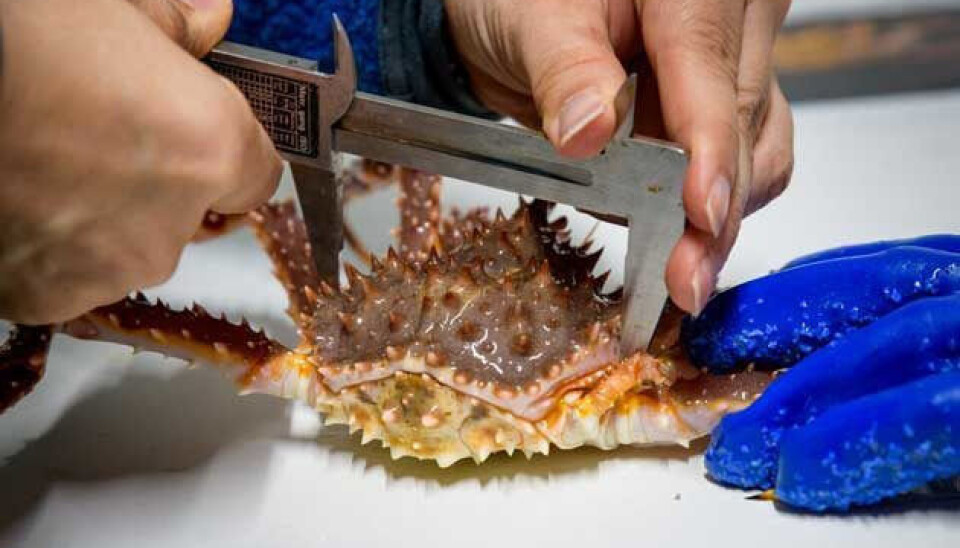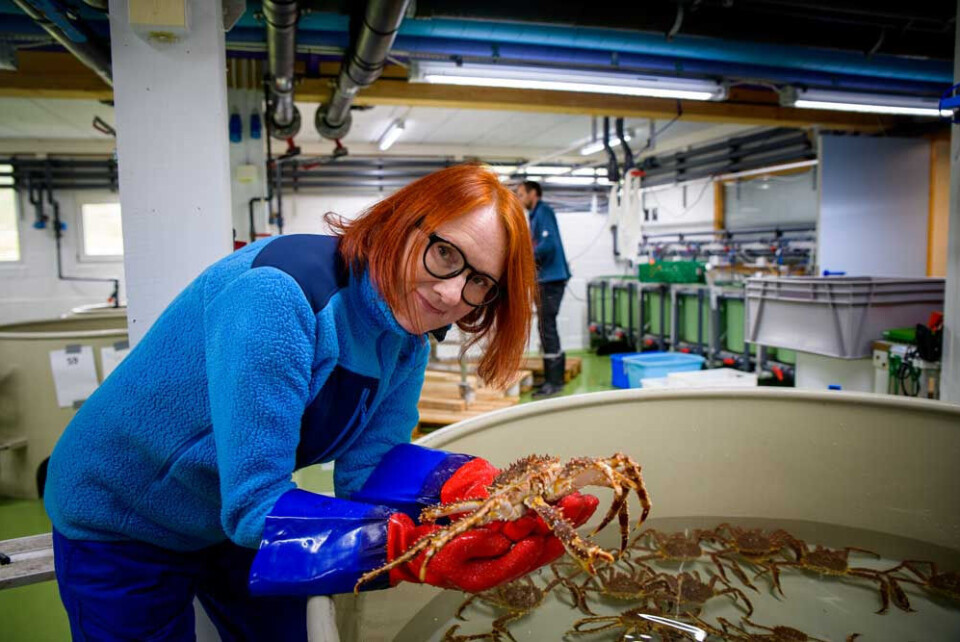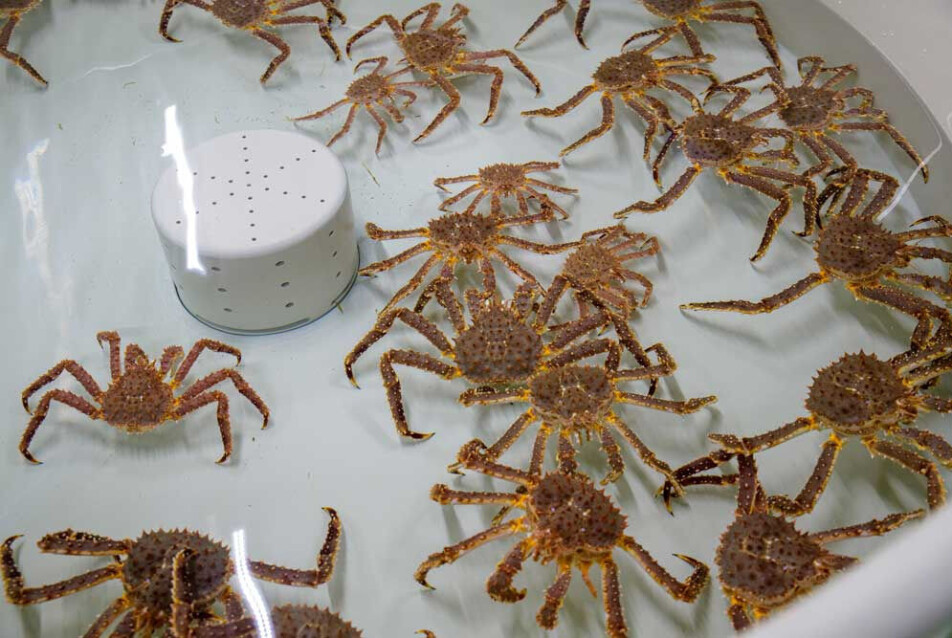THIS ARTICLE/PRESS RELEASE IS PAID FOR AND PRESENTED BY Nofima The Norwegian Institute of Food, Fisheries and Aquaculture Research - read more

Can feeding small red king crabs become an industry for the future?
Buyers in the international seafood market want Norwegian red king crabs to weigh at least 1 to 2 kilograms. So, what can be done when the crabs caught in the free fishing zone are too small?
Well, you catch them and feed them until they reach the desired weight before export.
This concept is what will be investigated in the research project called ‘Helt Konge’, which is now underway. The experiences so far have been both positive and somewhat challenging.
“We are investigating whether small red king crabs can be fed throughout live storage. For example, is it possible to feed them until they reach commercial product sizes? How fast do they grow? What is the survival rate? Finally, are they able to thrive in a seawater container?” senior scientist Grete Lorentzen, who is project leader of several crab projects at Nofima, summarises.
Quota-regulated and free fishing zone
The red king crab is a coastal species, and fisheries in Norway are divided into two parts: quota-regulated fishing and a free fishing zone. Quota-regulated fisheries are located in Eastern Finnmark. More specifically, east of 26°E – starting roughly at Honningsvåg.
The annual total quota there is approximately 2,000 tonnes, and the red king crab export value for 2021 was almost NOK 1 billion – which is an all time high.
The Norwegian authorities aim to limit the omnivorous crab from spreading further westwards, as this could have a negative ecological impact. Therefore, the aim of the open king crab fisheries is to catch all red king crab present west of Honningsvåg.
“We have seen that the diversity of naturally occurring benthic organisms has decreased in areas where the red king crab is caught. Therefore, there is no quota in the free fishing zone. The crabs caught in the free fishing zone must, regardless of size, be brought ashore alive,” Lorentzen explains.
Trials are now underway to determine whether crabs from the free fishing zone can survive being stored and fed until they reach the size that is of interest to the market. In the trials carried out so far, small red king crabs weighing approximately 500 grams have been fed over a two-year period with by-products from the prawn industry. The trial was carried out at the Aquaculture Research Station in Kårvika, just outside Tromsø.
“The results show that the crabs are growing well and seem to be thriving; after two years, the crabs increased to 800-1,000 grams,” Lorentzen states.

Same taste as wild-caught crab
During the two-year trial period, the crabs moulted up to three times. Crabs grow by shedding their shells. It is called moulting when they crawl out of their old shell, forming a new and larger shell.
“The crabs are vulnerable immediately after moulting, and there may be a risk that they injure each other. However, in our trial, the crabs were calm and seemed to socialise with each other," Lorentzen says.
Another equally important question for the scientists was whether the meat of farmed red king crabs tasted differently from that of wild-caught red king crab, which is commercially in high demand because of its delicate taste and texture.
“Taste tests showed that meat from the captured red king crab did not differ from the taste of wild-caught red king crab,” she says.
Challenges regarding meat content
The meat content of legs is an important quality characteristic for red king crabs. The meat content is assessed as the area of a cross section of the leg that is filled with meat.
The market wants the meat content to be at least 80 per cent. Research shows that this is a challenge when it comes to feeding the small crabs:
“In the trial, the crabs were well-fed throughout the entire period. However, the meat content was low. Compared to wild-caught red king crab, the red king crab that were fed had a lower meat content. This shows that there is still some work to be done before we reach our goal," Lorentzen says.
Therefore, Nofima has initiated a major project in which scientists will study the relationships between conditions for feeding small red king crabs and the attributes of the meat after processing.
“In this trial, we will vary the feed composition and feeding regimes, and we will closely monitor the well-being, injuries, and growth rates. The project will run over a three-year period, and we hope to get answers to questions we have about how the quality may be affected by how the crab is doing when fed in a container,” she says.
In the long term, she can also envisage that feeding of red king crab can take place at sea, for example in cages or net-pens that have been specially adapted for keeping the crabs.
“This will save the industry costs that are associated with tanks, pumping water, cleaning the tanks and so on. However, new challenges may arise along the way. These might involve feeding, water currents and consequences of varying temperatures,” Lorentzen points out.

Future industry
She believes that feeding of small red king crabs can become an industry for the future.
“If we succeed in our experiments, feeding of small crabs can be a valuable contribution to today’s exports of red king crab. This type of feeding will contribute to value creation and what used to be considered ‘a problem’ can be turned into a resource. Live storage and feeding can also contribute to new jobs primarily in Western Finnmark, but there is also a potential for new companies to establish activity in northern parts of Troms,” she states.
In addition, the scientist believes that targeted fishing for small red king crabs in the free-fishing zone will also contribute to fulfilling the regulatory authorities’ aim of reducing the prevalence of red king crab along the coast west of the 26°E .
“Exploitation of the stock in the quota-regulated area is high. If the red king crab industry is to experience growth, we therefore envisage that it must take place in other ways, such as through the controlled feeding of small red king crabs,” Grete Lorentzen says.

This article/press release is paid for and presented by Nofima The Norwegian Institute of Food, Fisheries and Aquaculture Research
This content is created by Nofima's communication staff, who use this platform to communicate science and share results from research with the public. Nofima is one of more than 80 owners of ScienceNorway.no. Read more here.
See more content from Nofima:
-
Red algae grown in wastewater from fish-farming facilities could become sustainable salmon feed
-
Pumpkins are good for more than just Halloween decorations
-
This is how temperature affects a salmon's health and growth
-
Study: Omega-3 and zinc is a powerful duo for salmon
-
Fish may turn yellow if frozen too fresh
-
Is it better if food is packaged in plastic or paperboard?




































